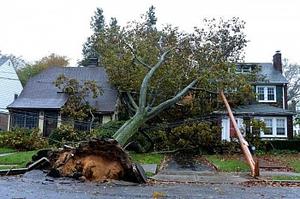DisastersOutlasting Superstorm Sandy
When hurricanes wander up the Atlantic Coast, Long Island’s topography is such that storms like Sandy, or last year’s Hurricane Irene, produce widespread, severe damage; effects can last for weeks, not only in the hardest-hit areas, but across the breadth of the island; Mark Zablocki, HSNW administrative editor, lives on Long Island, and he draws on his personal experience dealing with Sandy and its consequences to offer a few simple steps which, if followed, would help individuals analyze their own situation and the vulnerabilities and threats they face, pointing them in the direction of the best course of action to take in preparation for an impending disaster

This tree took a power line pole with it on Long Island // Source: lemonpress.ir
Living on New York’s Long Island has distinct advantages and disadvantages when considering hurricanes. Storms such as this year’s Hurricane Sandy rarely venture this far north, a decided advantage.
When hurricanes do wander up the Atlantic Coast, Long Island’s topography is such that storms like Sandy, or last year’s Hurricane Irene, produce widespread, severe damage. Effects can last for weeks, not only in the hardest-hit areas, but across the breadth of the island. The island’s long coastline and generally low topography leave the area vulnerable to high flooding and coastal erosion, and extensive wind damage, with it’s attendant downed trees and loss of power.
The infrequency of hurricanes in the region has also led to an apparent complacency on the part of the utilities that serve Long Island. Most of the area’s power supply is carried on above-ground, pole-mounted cables that are vulnerable to wind-driven knockdown, combining with tree-limb falls and the literal uprooting of century-plus aged trees. This causes multiple breaks in electrical supply lines that can take days or weeks to clear and restore. Road blockages by fallen trees and flooding are also common. The effect is island-wide.
To complicate matters for Long Islanders, winter storm Athena followed on Sandy’s heels, with high winds. Heavy, wet snow bought down an additional number of trees, severing the freshly-restored power lines across much of the island.
While preparing for Sandy’s unwelcome arrival, as with last year’s Hurricane Irene, a surprising condition presented itself. An astonishing number of people have no idea how to prepare for an event that will force them to be without power for days, or even weeks. They make matters worse by waiting until the last day, when supplies of essentials dwindle.
With simple situational analysis and preparation, those powerless days can become relatively pleasant, a forced respite from daily pressures. I know because I’ve done it.
An important note is that if local emergency authorities order or recommend that you evacuate, do so immediately. Rest assured that evacuation advisories are issued for a reason, and ignoring or refusing them has led to much avoidable suffering and loss of life. Prepare a “go bag” of essential items, including medications and pet food, and leave. Better to take an unnecessary trip than to risk injury or loss of life.
